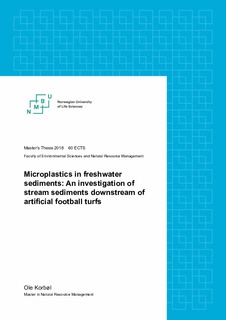| dc.contributor.advisor | Schneider, Susanne Claudia | |
| dc.contributor.advisor | Beylich, Bjørnar Andre | |
| dc.contributor.author | Korbøl, Ole | |
| dc.coverage.spatial | Norway | nb_NO |
| dc.date.accessioned | 2018-10-08T11:41:39Z | |
| dc.date.available | 2018-10-08T11:41:39Z | |
| dc.date.issued | 2018 | |
| dc.identifier.uri | http://hdl.handle.net/11250/2566868 | |
| dc.description.abstract | Due to climate conditions and a high demand of playing time there has been a rapid increase in the number of artificial football turfs in Norway in the last two decades. A rising concern linked to these turfs is the use of rubber granulate particles as infill and their possible emission to the environment. Estimations from Norway and Sweden indicate that the spreading of these particles potentially is one of the largest sources to microplastic emissions in the two countries. Presently there is little knowledge about the fate and abundance of these particles in the environment, and it is unclear to which extent granulate particles from artificial football turfs are spread to adjacent streams and rivers.
In this thesis, sediment samples from seven streams in Oslo, Asker and Bærum municipalities were examined, to investigate whether granulate particles from artificial football turfs are released to adjacent watercourses. Sediment samples were taken both upstream and downstream the turfs. 117 sediment samples were analysed, taken from four upstream and 28 downstream sampling stations. Each sediment sample represented a volume of 0,14 litre and was taken from the upper five cm of the sediment. Except three turfs, all the investigated turfs were used during winter time. In addition, they were all connected to watercourses either through drainage pipes or by surface runoff. To extract granulate particles, a combination of sieving and visual identification was used.
In total, granulate particles were found in 85,4% of the downstream sediment samples. The amount of granulate particles varied greatly between the streams and ranged from 0,0008 to 6,67g per sample (equals to 0,006 to 47,3 g/litre). The number of granulate particles ranged from 1 to 1672 particles/sample (equals to 1 to 11830 particles/litre). Generally, there were found more granulate particles at stations located closest to the turfs, compared with those further downstream. However, granulate particles also were found at all upstream stations, as well as up to 4.3 km downstream, indicating that granulate particles have the ability to spread far and “randomly”, i.e. not only downstream along waterways. In addition, it appears that the location of the turfs, winter operations and the placement of snow during winter time is crucial in terms of the amount of granulate particles that are released to adjacent waterways. The results from this study show that spreading of rubber granulate from artificial football turfs to adjacent waterways is a major problem, and measures must be implemented to prevent further spreading in the future. | nb_NO |
| dc.description.abstract | På grunn av klimaforhold og en stor etterspørsel etter spilletid har det vært en rask økning i antallet kunstgressbaner i Norge de siste to tiårene. En økende bekymring knyttet til disse banene er bruken av gummigranulat som fyllingsmateriale og de mulige utslippene av granulat partikler til miljøet. Estimater fra Norge og Sverige indikerer at spredning av slike partikler potensielt kan være en av de største kildene til mikroplast utslipp i de to landene. Det finnes i dag lite kunnskap om skjebnen og mengden av disse partiklene i miljøet, og i hvilken grad gummigranulat fra kunstgressbaner blir spredt til nærliggende bekker og elver er uklart.
I denne studien ble det undersøkt sediment prøver fra syv bekker i Oslo, Asker og Bærum kommune, hvor målet var å undersøke om granulat partikler fra kunstgressbaner blir sluppet ut til nærliggende vassdrag. Sediment prøver ble tatt både oppstrøms og nedstrøms kunstgressbanene. Totalt ble 117 sediment prøver analysert, fordelt på fire oppstrøms og 28 nedstrøms prøve stasjoner. Hver sediment prøve representerte et volum på 0,14 liter og ble tatt fra de øverste fem cm av sedimentet. Bortsett fra tre baner, hadde alle banene i studien vinterdrift. I tillegg var alle banene tilknyttet nærliggende vassdrag, enten gjennom overflate avrenning eller gjennom dreneringsrør. For å identifisere granulat partiklene ble det benyttet en kombinasjon av sikting og visuell identifisering.
Totalt ble granulatpartikler funnet i 85,4 % av alle nedstrøms prøver. Mengden i disse prøvene varierte stort mellom de ulike bekkene, fra 0,0008 til 6,67 g per prøve (tilsvarende 0,006 til 47,3 g/liter). Antallet granulatpartikler varierte fra 1 til 1672 partikler/prøve (tilsvarende 1 til 11830 partikler/liter). Generelt ble det funnet flere granulat partikler i prøvene som ble tatt nærmere banene, sammenlignet med de lenger nedstrøms. Det ble også funnet granulatpartikler ved alle oppstrøms stasjoner og opptil 4,3 km nedstrøms. Dette er en indikasjon på at partiklene har muligheten til å spre seg langt og «tilfeldig», dvs. ikke bare nedstrøms for banene. I tillegg, ser det ut til at lokaliseringen av banene, vinterdrift og plassering av snø gjennom vinteren har stor påvirkning på mengden granulatpartikler som spres til nærliggende vassdrag. Dette studie viser at spredning av gummigranulatpartikler fra kunstgressbaner til nærliggende vassdrag er et stort problem, og tiltak må iverksettes så fort som mulig for å hindre videre spredning i fremtiden. | nb_NO |
| dc.language.iso | eng | nb_NO |
| dc.publisher | Norwegian University of Life Sciences, Ås | nb_NO |
| dc.rights | Attribution-NonCommercial-NoDerivatives 4.0 Internasjonal | * |
| dc.rights.uri | http://creativecommons.org/licenses/by-nc-nd/4.0/deed.no | * |
| dc.title | Microplastics in freshwater sediments : an investigation of stream sediments downstream of artificial football turfs | nb_NO |
| dc.type | Master thesis | nb_NO |
| dc.description.localcode | M-NF | nb_NO |

